The Belt and Road Initiative is to open a new chapter in Xinjiang
“Future Textile Road — The Future of the New Textile Industry: A Dialogue between Xinjiang, China and Europe” successfully held in Urumchi
May 25, 2017 | by Zhao Zihan

“Future Textile Road — The Future of the New Textile Industry: A Dialogue between Xinjiang, China and Europe” jointly organized by the Leading Group Office for Development of Employment-Centered Textile and Apparel Industry in Xinjiang Uygur Autonomous Region, China Textile Information Center and Santex Rimar Group, was successfully held in Urumchi on May 16th, 2017. The Forum aims to build an innovative platform based on the exploration into the long-term construction of the future development potential of Xinjiang’s high-end textile industry and the the China-EU textile industry chain cooperation system, so as to open a new dialogue between the Asian continent and the Mediterranean region in the field of high-end textiles.
Zhao Qing, Vice Chairman of People’s Government of Xinjiang Uygur Autonomous Region, Gao Yong, Party Secretary & Secretary-General of China National Textile & Apparel Council (CNTAC), Liang Yong, Deputy Secretary-General of People’s Government of Xinjiang Uygur Autonomous Region, and Director of Leading Group Office for Development of Employment-Centered Textile and Apparel Industry in Xinjiang Uygur Autonomous Region, Yang Zhaohua, Vice President of CNTAC & President of China Home Textile Association, Peng Yanli, Deputy Secretary-General of CNTAC & President of China Wool Textile Association, Qiao Yanjin, Director of Productivity Promotion Department of CNTAC & Director of China Textile Information Center, as well as Ferdinando Businaro, President of Santex Rimar Group, and Stefano Gallucci, CEO of Santex Rimar Group attended the Forum. In addition, more than 200 people from China Cotton Textile Association, China Nonwovens & Industrial Textiles Association, China Textile Machinery Association and related governmental departments of Xinjiang Uygur Autonomous Region, as well as the authoritative media from home and abroad participated in the Forum.
Top perspectives:
Leveraging the Belt and Road Initiative to contribute to the textile and garment industry in Xinjiang

Zhao Qing, Vice Chairman of People’s Government of Xinjiang Uygur Autonomous Region
Zhao Qing said in his welcoming speech that Xinjiang is constantly improving its policies to further promote industrial agglomeration, speed up the expansion of the western market, raise labor productivity and solve the financing problems, creating a more favorable development environment and guaranteeing fast, healthy, and sustainable development of textile and garment industry. He also pointed out that Xinjiang as a distribution center for Chinese goods to the west will become a bridge and link between China and Europe in terms of trade and cooperation, also a window to the world and a platform for the world to have a better understanding of China. Thanks to the Belt and Road Initiative and the Schema for Development of Employment-Centered Textile and Apparel Industry, Xinjiang has become a hot spot for national textile and garment industry investment. According to the Ten-Year Program, China’s largest cotton textile production base and the largest garment export processing base in the western region will have been established in Xinjiang by 2023 when Urumchi City will become a fashion capital of Central Asia.

Gao Yong, Party Secretary & Secretary-General of China National Textile and Apparel Council
Gao Yong pointed out that Xinjiang has ushered in an important historical development opportunity to build new competitive advantages. It would be a long way for the soaring development of Xinjiang textile and garment industry, during which the government leadership and coordination, market allocation of resources, and the active participation of enterprises and the community are all required to ultimately form a three-dimensional promotion pattern integrating government guidance, market operations, enterprise dominance, and civil promotion. He also stressed that it is expected that the Forum would create an open and efficient platform for international cooperation and build a more closely and strong network of partners, hand in hand to promote a wider, higher-level, deeper industry exchanges and integration. Thereupon, promoting the implementation of the Belt and Road Initiative is to bring the ancient Silk Road new vigor and vitality, so as to make the Sino-EU textile industry more closely in a new form towards a new historical height based on mutually beneficial cooperation.

Liang Yong, Deputy Secretary-General of People’s Government of Xinjiang Uygur Autonomous Region, and Director of Leading Group Office for Development of Employment-Centered Textile and Apparel Industry in Xinjiang Uygur Autonomous Region
Liang Yong gave a detailed introduction to the advantages of textile and garment industry in Xinjiang, national strategy and industry opportunities, industry status quo and future development goals, and Xinjiang-EU cooperation outlook. He pointed out that Xinjiang is China’s largest cotton production base, with abundant energy resource advantages, unique land resource conditions, convenient transportation resources and strong national policy support, which have laid a solid foundation for the rapid development of Xinjiang textile and garment industry.
Based on the development in recent years, Xinjiang has become one of the most competitive areas of China’s textile and garment industry, enjoying almost the same costs as Vietnam and other Southeast Asian regions. Last year, Xinjiang saw an increase of 525 new textile and garment enterprises, while the above-designated enterprises witnessed the main business income of 37.799 billion yuan with an increase of 59.4%, achieving profits of 3.1 billion yuan; the industrial pattern including three comprehensive bases, seven key industrial parks, and three garment bases was basically formed. With regard to the strategic development goals in 2017, Xinjiang will invest no less than 72 billion yuan in fixed assets, complete the new employment of 100,000 people, achieve a growth of more than 40% in industrial added value, and attract 400 enterprises from the Mainland, making Xinjiang become an industry cluster highland from the policy depression to enhance the rapid development of local garment industry.
Qiao Yanjin, Director of Productivity Promotion Department of CNTAC & Director of China Textile Information Center
Qiao Yanjin said during an interview after the meeting that in the future China Textile Information Center will strengthen closer communication with Xinjiang government agencies at all levels for extensive and in-depth cooperation in terms of product creative development, channel platform construction, the establishment of standard systems, and personnel training based on the local development needs, by virtue of the rich experiences in providing services to the textile industry clusters for many years, so as to contribute to Xinjiang textile and garment industry transformation and upgrading.
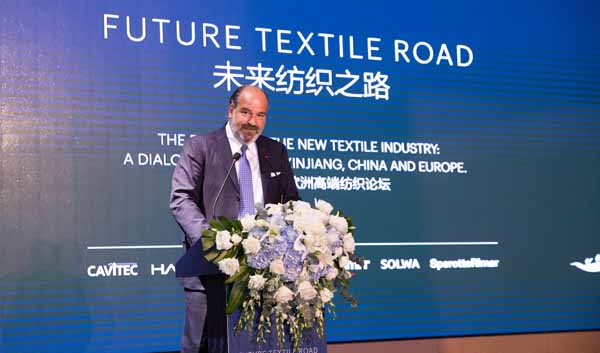
Ferdinando Businaro, President of Santex Rimar Group
Ferdinando Businaro said that the spirit of the new Silk Road not only means the world shared cultural and historical heritage, but also represents the East-West cultural ties and cooperation. The Group has a history of a hundred years and is able to adapt to a variety of cultures, providing cooperation in textile deep processing technology and global machinery supply. A few years ago, the Group started and continued to strengthen its partnership with China. Currently, its customers in China have covered such areas as Guangdong, Jiangsu, Shandong, Hebei and Xinjiang. In the future, the Group will continue to tap the potential and open up new markets. As one of the organizers of this Forum, Santex Rimar Group will continue to support the development of China’s textile industry, and jointly promote the development of the new Silk Road.
Based in Xinjiang:
Adhering to the main industry to accelerate the fashion, high-end, branding, and internationalization process

Sun Weiting, Huafu Top Dyed Melange Yarn Co., Ltd.
Sun Weiting pointed out that in 2017 the central government invested 1.5 trillion yuan for infrastructure construction in Xinjiang, giving domestic and foreign textile and garment enterprises more expectations in the future there. Huafu began its investment in Xinjiang in 2006 through acquisition of the cotton mill in the Aksu area, and more than a decade later, the current total investment has reached about 5 billion yuan with the employment of 14,700 people. In the future, Huafu will build large-scale cotton farms in Xinjiang to promote the intensive cultivation of cotton industry. It will see cotton processing capacity of one million tons through acquisition of 100 ginning plants, about 1.5 million tons of logistics capacity in the southern and northern Xinjiang, and two dyeing centers in Aksu and Shihezi. It is expected that in 2018 the color-spun fabric production will be achieved in Xinjiang, giving full play to the green effect of color-spun industry.

Su Xiao, President of Shandong Ruyi Group
In recent years, Shandong Ruyi Group has sped up its international layout along the Belt and Road, while establishing an Internet + intelligent manufacturing + personalized custom business model based on the transformation and upgrading in Xinjiang. The Group also attaches great importance to resource integration through “Go Global” activities such as capital cooperation, investment mergers and acquisitions, industry alliances, etc., speeding up the layout along the two ends of the industrial chain to accelerate the internationalization process. Thanks to the integration of resources, Ruyi has been enjoying two world’s largest complete textile and garment industrial chains from cotton spinning, wool spinning to garments. Ruyi, as a forerunner in the economic development along the Belt and Road, has witnessed a regional construction layout covering such areas as Xinjiang, Ningxia, and Pakistan, investing 30 billion yuan to build textile manufacturing industrial park and supporting energy projects so as to speed up the implementation of industrial transformation and upgrading and promote the development quality of enterprises.
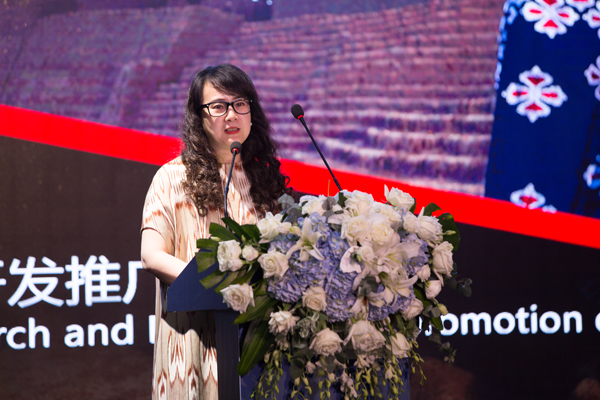
Cheng Yingfen, Design Director of Xinjiang Adlas Silk R&D and Promotion Center
Adlas silk, a kind of warp tie-dyed silk fabric, is known as the “living fossil on the ancient Silk Road”. According to Cheng Yingfen, Adlas silk is a blend of various cultures, and it is like a link that connects China with many countries such as Iran, Turkey and many Central Asian countries. Xinjiang’s Adlas silk products have been exported to 25 countries and regions including Japan, Kyrgyzstan, Kazakhstan, and Pakistan. As the last silk handmade process in the 21st century, and after more than 1,000 years of development, it has not only been a kind of fabric, but also a national cultural sense of rich historical accumulation.
Elite gathering:
Sharing innovation experiences to promote the sustainable development of Xinjiang textile and garment industry

Calvin Woolley, Global Supplier Development Leader - Textiles Categories at IKEA Group
Calvin Woolley said that “Creating a better daily life for the public” is the development vision of IKEA Group which provides a wide range of beautiful and practical household goods that people can afford. Optimizing the industrial chain not only makes the cost lower and the products better, but also exerts positive impacts on the human and the environment. IKEA’s textile products are constantly committed to material and technology innovation, and continue to improve the product supply chain. For example, the enterprise has joined in Better Cotton Initiative, and after several years of hard work, IKEA 100% cotton products can be traced back to cotton field. It is anticipated that in the future each product is to be made from sustainable and traceable raw materials.
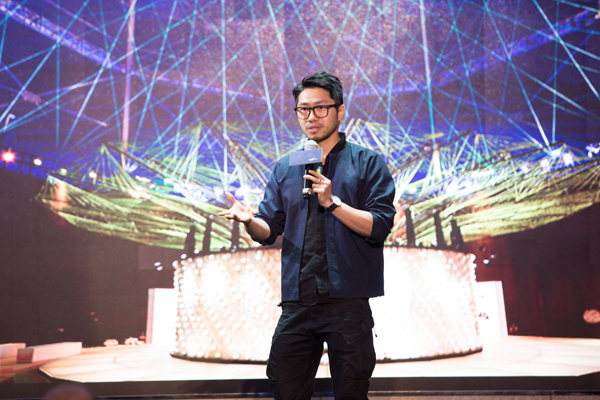
Arthur Huang, Founder and Chief Executive Officer of MINIWIZ
Miniwiz develops and sells materials 100% recycled from waste, but also re-engineers them into various applications. It recycles trash - including electronic, food, agricultural, packaging and automotive waste - into products like cellphone cases, sunglasses, interior applications, and construction materials. Miniwiz claims that most of post-consumer, agricultural and industrial waste can be recycled into materials that, if enhanced, can be reused to substitute any virgin material.
Arthur Huang pointed out that the product recycling rate in the United States is about 30%, while that in Germany reaches 62%, the highest in the world. However, in China the recovery rate of physical packaging, clothing, and construction waste is very low. In order to allow more people to accept and use the recyclable materials, Arthur Huang put forward the concept of “sexy waste” which is to make the product sexy to attract more consumers to use this waste, turning it into a treasure. For example, the building made from 1.5 million recycled PET bottles, without using any adhesive, has passed all building standard inspection and carbon emissions detection. The Nike shoes designed by the company in March 2017 are all made from recycled materials.

Giovanni Bonotto, Creative Director of BONOTTO s.p.a.
Bonotto s.p.a. is a fourth-generation textile manufacturer founded in 1912. The company has grown rapidly becoming a complete-cycle vertical industry, with several production sites and employing over two hundred masters of art. Giovanni Bonotto said that the company focuses on product innovation and technological innovation, and has survived the European market for many years. In order to produce more innovative products of artistic value, the company invites artists to participate in the entire production process to offer advice and suggestions for product development, which has brought a lot of innovative vitality to the products. Artists can discover the beauty of things, combining reality with imagination to inspire innovation. Giovanni Bonotto pointed out that the company’s production always starts from the artistic and creative point of view, thus creativity and the courage for trying are integrated into the spirit of corporate culture. Under the guidance of such a concept, both the front-line workers and designers of the company are filled with creative DNA.
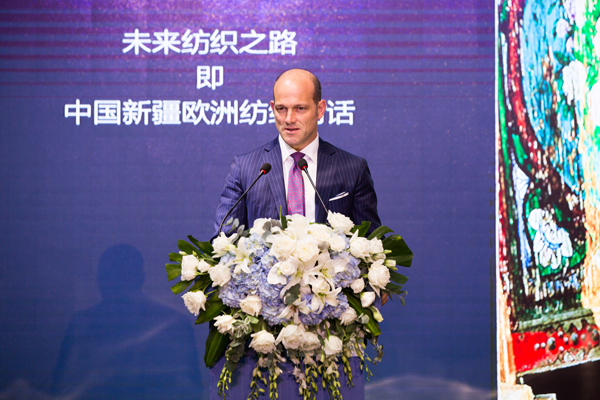
Stefano Gallucci, CEO of Santex Rimar Group
SANTEX RIMAR GROUP is one of the leading players in the world market of textile finishing, technical textiles and green technologies for water treatment and drying processes. The Group is a machine manufacturer and a technology partner for knitted, woven and nonwoven fabrics and green solutions. The Group focuses on cooperation and innovation to create a better future. In cooperation with chemical companies, the Group has developed a new type of sustainable development technology; working with Benetton Group to develop a new textile technology using plasma energy to reduce the use of chemicals and contaminants to produce high-quality textiles. He said that SANTEX RIMAR GROUP is willing to participate in the practice of the Belt and Road Initiative to help Xinjiang develop the textile industry from yarn to high-quality fabrics, and to strengthen the dialogue between Xinjiang China and Europe, creating a new link among various countries in the future.
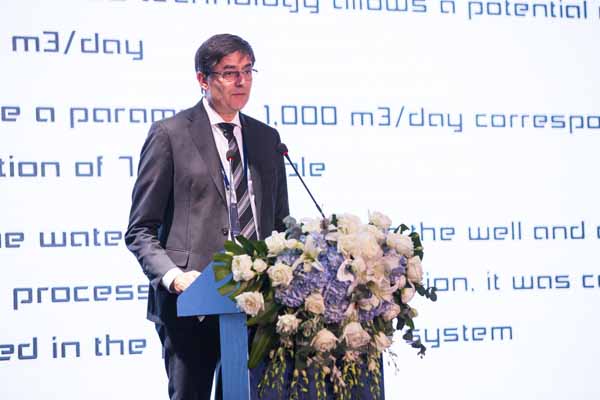
Pietro Pin, New Technology Research and Development Leader of Benetton Group
Benetton Group is one of the best-known fashion companies in the world, present in the most important markets in the world with a network of about 5,000 stores; a responsible group that plans for the future and lives in the present, with a watchful eye to the environment, to human dignity, and to a society in transformation. Pietro Pin said in his speech that the Group used a plasma treatment to change the structure of the wool fiber and make the real change. In addition, the use of innovative water-saving and energy-saving technologies greatly reduced the use of water, playing a sustainable development role in the entire industrial process. Through the entire product dyeing process, the application of innovative technology and a small amount of chemicals can give more stable dyeing colors which are not easy to fade, enjoying 50% water recovery in the water treatment process.
Francesco Dalla Rovere, President of SINV Group
Francesco Dalla Rovere said that the Group was established more than 40 years ago and has a self-contained mechanism and operating system, focusing on markets outside the EU and working with a number of distributors to cover the various regions. For each dealer and broker, SINV Group is able to provide a series of sample collection services while collecting in various markets to accelerate the entire production process. SINV Group has three different production methods: direct production in Italy when fabrics cannot be bought in other places; production at abroad while the fabrics and raw materials are bought at home; direct procurement of finished products from abroad. Different markets need different penetration strategies; therefore, the Group has a distribution network to know more about the entire market and monitor the world market.

Cristiano Seganfreddo, Artistic Director of KRIZIA
Cristiano Seganfreddo stated that since the last few decades, the Italian fashion industry has been increasingly better, and become the world’s fashion capital which is mainly due to more creativity and diversity. Italian fashion companies attach great importance to culture, ready to dialogue with countries and people around the world. The dialogue with China’s Xinjiang will explore more business opportunities. At present, China has become the world’s largest cultural and economic country, and accordingly China’s textile industry will become more and more powerful through constant educational and technological promotion. It is believed that the Belt and Road Initiative will benefit the whole world by opening up the link between China and other relevant countries in the world through a new dialogue in a solid and effective way to build a platform for East-West communication .
Diversified activities to build a win-win cooperation and innovative platform
The Forum was featured with a variety of forms and rich contents. In addition to the professional exchanges, the Forum also opened a static display space, showing a series of women’s wear under the leading design of Ms. Zhu Chongyun, Founder, President, and Creative Director of Marisfrolg Group, Xinjiang high-count cotton yarn, Xinjiang hand-made flower caps, camel-hair products, Adlas silk, European fabrics and other products, highlighting the concept of sustainable development.





On May 17th, the organizers, together with the representatives of participant enterprises, visited Urumchi International Inland Port Area, Xinjiang Esquel Textile Co., Ltd. and Xinjiang Ruyi Woolen Textile Co., Ltd. for study and professional exchanges. The interactions between home and abroad, the land and sea modern comprehensive transportation hub and trade logistics center, and the scientific and technological innovation and development results of leading enterprises, really shocked everybody there who also felt the new vitality of the core economic belt of the Silk Road through the prosperous textile and garment industry in Xinjiang.

The representatives are visiting Urumchi International Inland Port Area

The representatives are visiting Xinjiang Ruyi Woolen Textile Co., Ltd.








